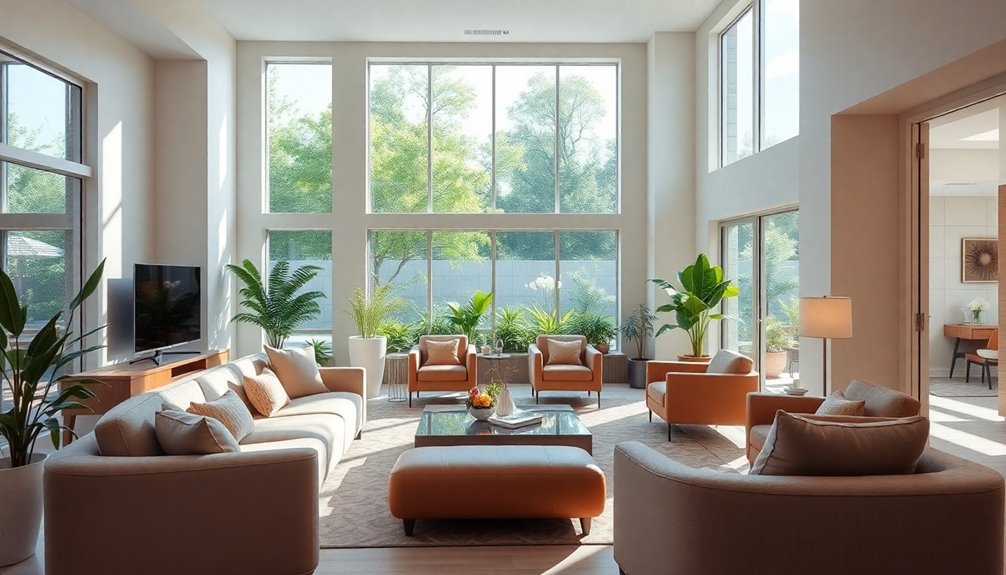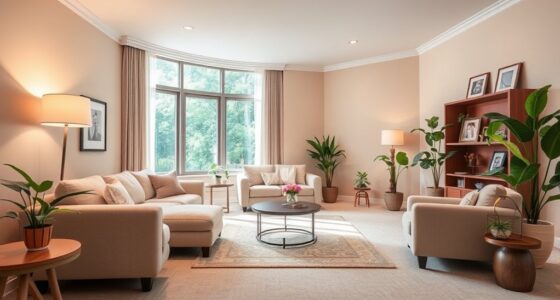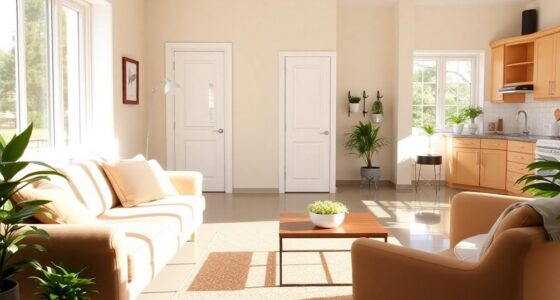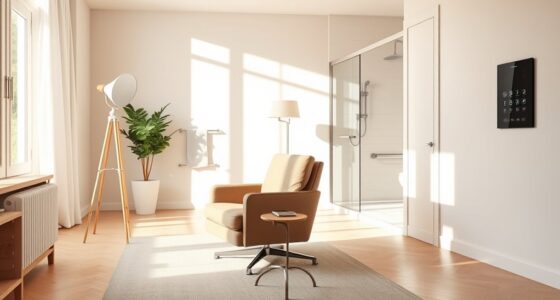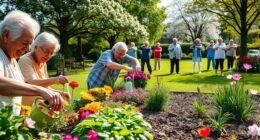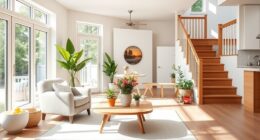You'll find that contemporary senior homes are adopting age-friendly design trends that prioritize adaptation, safety, and comfort. Features like no-step entrances and wider hallways improve mobility, while natural elements, such as gardens, foster well-being. Technology is also enhancing the living experience, offering smart solutions for safety and social connection. Personalized care in homelike settings creates a sense of belonging. Discover how these innovations can elevate quality of life in senior living spaces.
Key Takeaways
- Adaptable living spaces with no-step entrances and wider hallways enhance mobility and accessibility for seniors.
- Incorporation of communal areas fosters social interaction, reducing feelings of isolation among residents.
- Integration of gardens and green spaces promotes well-being and encourages outdoor activities.
- Smart home technology improves safety and provides convenience, allowing for independent living.
- Personalized care models and diverse dining options cater to individual preferences and enhance the sense of belonging.
Importance of Adaptation in Senior Living Design
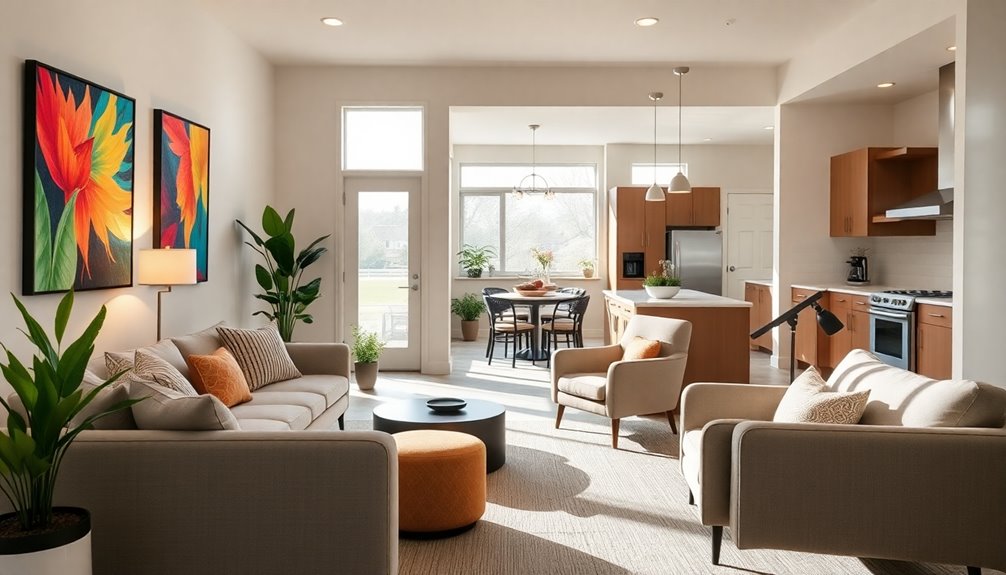
As the senior population continues to grow, adapting design in senior living spaces becomes vital to meet the evolving needs of residents.
You'll find that prioritizing adaptability in design not only enhances safety and accessibility but also guarantees that spaces remain functional as health and mobility change over time.
Modern materials and technology are increasingly integrated to foster communal areas that promote social interaction, which is essential for well-being.
By focusing on these design aspects, you create an environment that supports independence while addressing the diverse requirements of older adults.
Staying informed about these design trends allows you to cultivate a supportive atmosphere that evolves alongside your residents, ultimately enhancing their quality of life. User privacy is also a crucial consideration in designing these spaces to ensure residents feel secure and respected.
Key Design Trends Enhancing Quality of Life
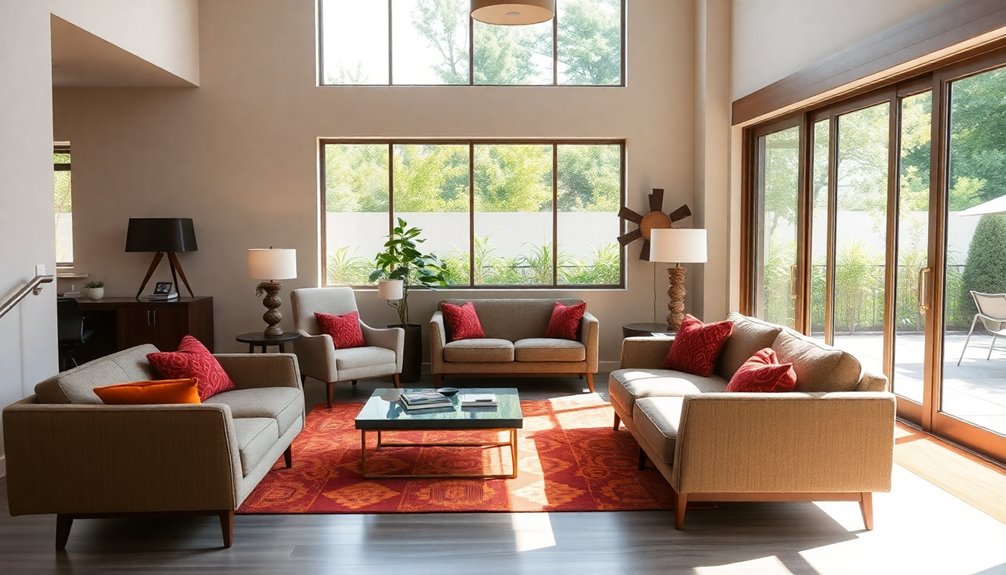
When it comes to enhancing quality of life in senior homes, prioritizing safety and comfort is key.
You'll find features like no-step entrances and wider hallways that make mobility easier, while integrating nature and outdoor spaces helps boost mood and well-being.
These thoughtful design trends not only cater to accessibility but also create inviting environments that foster connection and engagement.
Safety and Comfort Focus
Safety and comfort are essential components in the design of modern senior homes, directly impacting residents' overall quality of life. By prioritizing these elements, you create spaces that truly support aging individuals.
Key design trends include:
- No-step entrances for easy access
- Wider hallways promoting mobility
- Enhanced lighting to prevent accidents
- Thoughtfully designed communal areas for social interaction
Utilizing universal design principles guarantees that environments are adaptable and user-friendly for individuals of all ages and abilities. Additionally, incorporating features inspired by historic farmhouse preservation adds a layer of charm and connection to the past, enriching the living experience.
Incorporating modern materials and technology adds to the comfort of these spaces, making them welcoming and livable. Altogether, these features not only enhance safety but also foster a sense of independence, allowing residents to thrive in their homes.
Nature Integration and Accessibility
Integrating nature into senior living environments not only elevates the aesthetic appeal but also greatly boosts residents' well-being. By incorporating gardens, green spaces, and ample natural light, you create a tranquil atmosphere that fosters connection to the outdoors.
Prioritizing accessibility is key; features like wider pathways and no-step entrances make it easier for seniors to enjoy these outdoor areas, enhancing their ability to age in place. Access to these spaces encourages social interaction and physical activity, essential for maintaining health and combating isolation.
Large windows and skylights improve lighting and air quality, promoting overall wellness. Thoughtful landscaping with sensory gardens provides therapeutic benefits, stimulating cognitive functions and offering a peaceful retreat for those dealing with stress or anxiety. Additionally, investment in accessibility features can significantly enhance the overall quality of life for seniors, ensuring their needs are met as they navigate their living spaces.
Optimizing Resident Privacy and Dignity
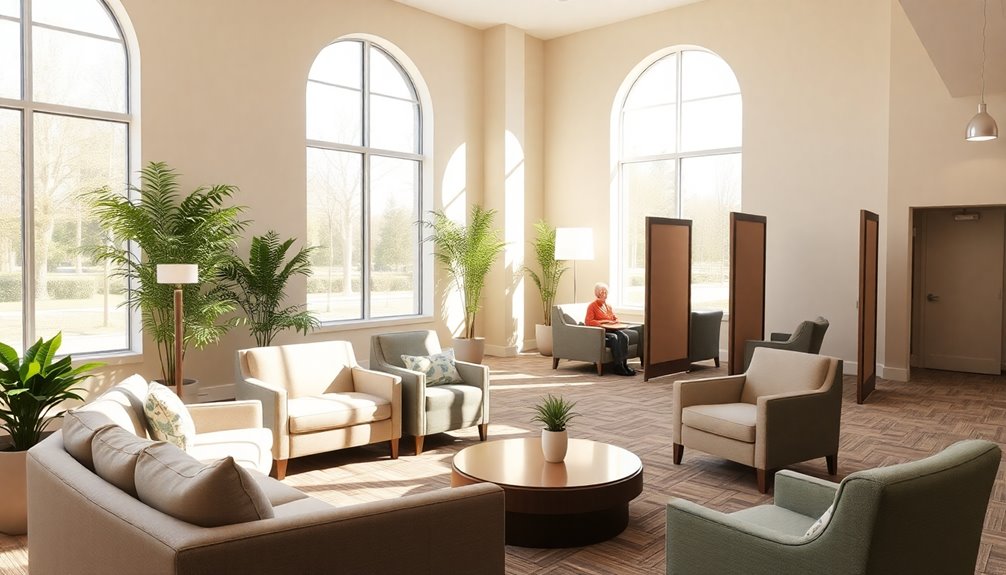
As senior living facilities evolve, prioritizing resident privacy and dignity has become essential for enhancing the overall quality of life.
The shift to all-private rooms allows you to enjoy your personal space, promoting comfort and a sense of ownership. Private bathrooms with three-fixture setups further enhance your dignity during personal care.
Consider these key elements:
- Private rooms foster a sense of independence.
- Dedicated bathing facilities reduce vulnerability.
- Nonprofit initiatives aim for affordable privacy.
- High-quality operators meet the growing demand for dignity.
These design trends reflect a commitment to ensuring that you can live with the respect and comfort you deserve, making your experience in senior living truly fulfilling.
Creating Homelike Settings

When you think about senior living, imagine environments that feel more like home and less like a facility.
Creating intimate living spaces with residential-style care design not only enhances comfort but also fosters community.
Intimate Living Environments
Creating intimate living environments for senior homes can markedly enhance residents' well-being and sense of belonging. By fostering residential-style care within smaller facilities of 8-10 bedrooms, you promote strong community ties.
These non-institutional settings prioritize a homelike atmosphere, improving the quality of life for seniors.
Consider the benefits of these environments:
- Personalized care that respects dignity
- Common living and dining areas that encourage socialization
- Reduced feelings of isolation and loneliness
- Affordable private accommodations for comfort
With the Green House movement leading the way, the shift towards smaller neighborhoods creates a welcoming space where seniors can thrive. Narcissistic abuse can also be a concern for some seniors, highlighting the importance of emotional support in these intimate settings.
Embracing these intimate living environments allows everyone to feel truly at home.
Residential-Style Care Design
Intimate living environments set the stage for a new approach to senior care that prioritizes comfort and familiarity. Residential-style care encourages the development of smaller, welcoming neighborhoods with 8-10 bedrooms, enhancing social engagement and a sense of belonging. Non-institutional designs foster dignity and individuality, moving away from traditional institutional feels. High-quality operators are now focusing on private accommodations, offering residents their own rooms with three-fixture baths for increased privacy. Additionally, creating homelike settings can significantly improve residents' emotional and social well-being.
| Feature | Description |
|---|---|
| Bedroom Count | 8-10 bedrooms per neighborhood |
| Common Areas | Shared living and dining spaces |
| Design Style | Non-institutional, homelike settings |
| Resident Privacy | Private rooms with three-fixture baths |
| Community Engagement | Promotes social interaction and belonging |
Non-Institutional Atmospheres
Many senior living facilities are embracing non-institutional atmospheres that prioritize comfort and familiarity. This shift creates a home-like setting where residents feel valued and at ease.
You'll find smaller, intimate spaces that house just 8-10 residents, fostering a sense of community.
- Enjoy private living spaces with three-fixture baths for enhanced privacy.
- Connect with neighbors in a personalized community designed for social interaction.
- Experience welcoming environments that promote dignity and comfort.
- Discover affordable options provided by nonprofit organizations alongside high-quality private-pay choices.
These design trends not only enhance the overall living experience but also guarantee that every resident feels at home, surrounded by warmth and companionship.
Introducing Hospitality Design Concepts
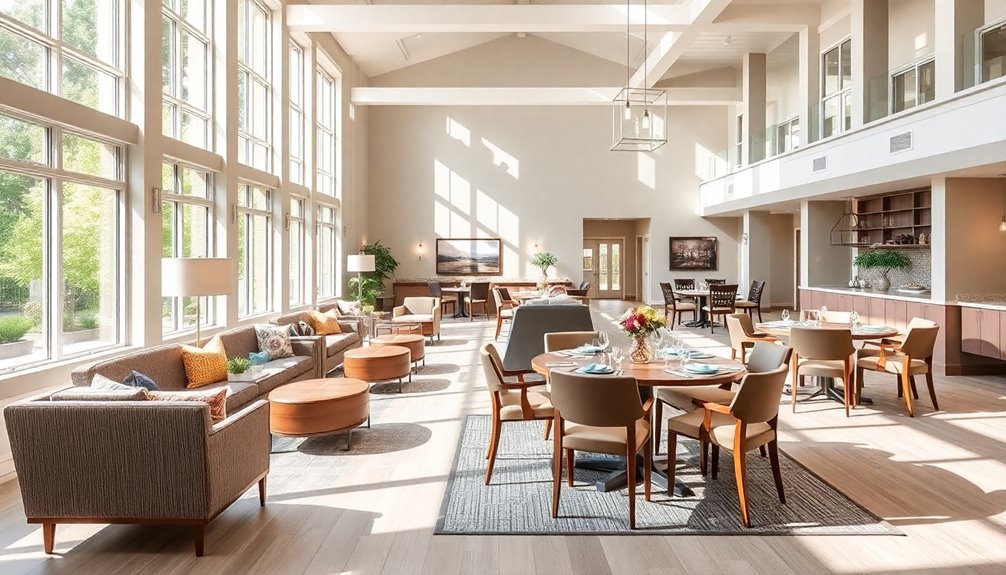
As senior living facilities evolve, they're increasingly embracing hospitality design concepts that prioritize comfort and warmth.
By incorporating hotel-like elements, these facilities create inviting environments that move away from traditional institutional aesthetics. You'll find enhanced dining options and services reminiscent of high-end hotels, making meals a more enjoyable experience.
Attractive materials comply with healthcare codes, ensuring safety while boosting aesthetic appeal for frail elderly residents. Thoughtful layouts and decor enhance the living experience and foster a sense of community among residents.
Furthermore, the focus on hospitality design encourages amenities and services that promote social interaction and engagement, greatly contributing to your overall well-being.
Enjoy a space designed not just for living, but for thriving in a welcoming community.
Expanding Individual Choice in Senior Living
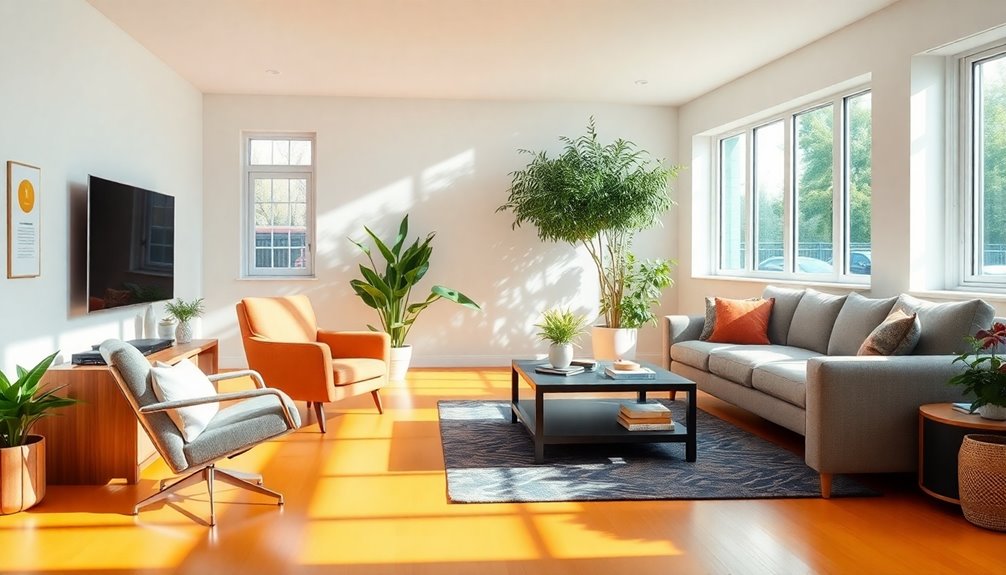
With the growing demand for diverse retirement options, senior living facilities are transforming to offer residents more individual choices than ever before.
This shift emphasizes individual preferences and enhances customization in various aspects of living. You can now enjoy:
- Flexible care models that adapt to your unique needs
- Tailored activity plans that reflect your interests
- Diverse dining options that suit your taste
- Social engagements that foster connections with like-minded peers
These advancements empower you to create a living experience that aligns with your lifestyle and values. Additionally, understanding state tax rates can help you make informed financial decisions as you navigate your retirement options.
By embracing enhanced customization, senior living facilities aren't just providing services; they're promoting autonomy and improving your overall quality of life.
It's all about making your senior years truly fulfilling!
Using Technology to Enhance Senior Living

While technology continues to evolve, it's becoming an integral part of enhancing senior living environments. Smart home features, like automated lighting and temperature controls, provide safety and convenience, allowing you to live independently with ease.
Health monitoring systems, including wearable devices and sensors, give real-time data, ensuring timely care and peace of mind for both you and your family.
Robotics also play a role by delivering necessary items on demand, reducing staff burdens and improving your experience.
Additionally, virtual reality technology creates immersive experiences that engage you and help combat feelings of isolation.
With training programs for both staff and residents, you'll easily adapt to these tech-enhanced living environments, making life more enjoyable and connected. Furthermore, the integration of AI technology in retail can also be leveraged to improve service delivery in senior living facilities.
Filling in the Continuum of Care
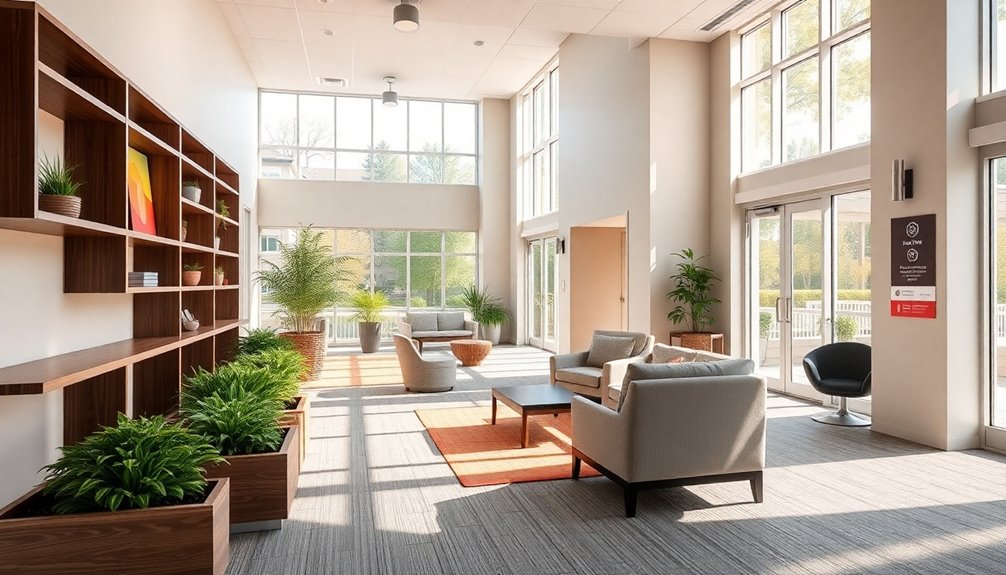
In recognizing the diverse needs of seniors, facilities are now being designed to offer a full spectrum of care, guaranteeing you can shift smoothly between independent living, assisted living, and skilled nursing as your health changes.
This continuum of care is essential for the aging population, providing security and comfort.
Consider how this environment can enhance your quality of life:
- Maintain independence while receiving support
- Foster connections with peers across different care levels
- Enjoy seamless changes based on evolving needs
- Access tailored care within one welcoming Senior Living Facility
These factors contribute to a vibrant community, allowing you to thrive at every stage of life. Additionally, understanding assisted living expenses can help you make informed choices about your care options.
Embracing these trends guarantees a fulfilling and supportive living experience.
Redefining Continuing Care Retirement Communities (CCRCs)
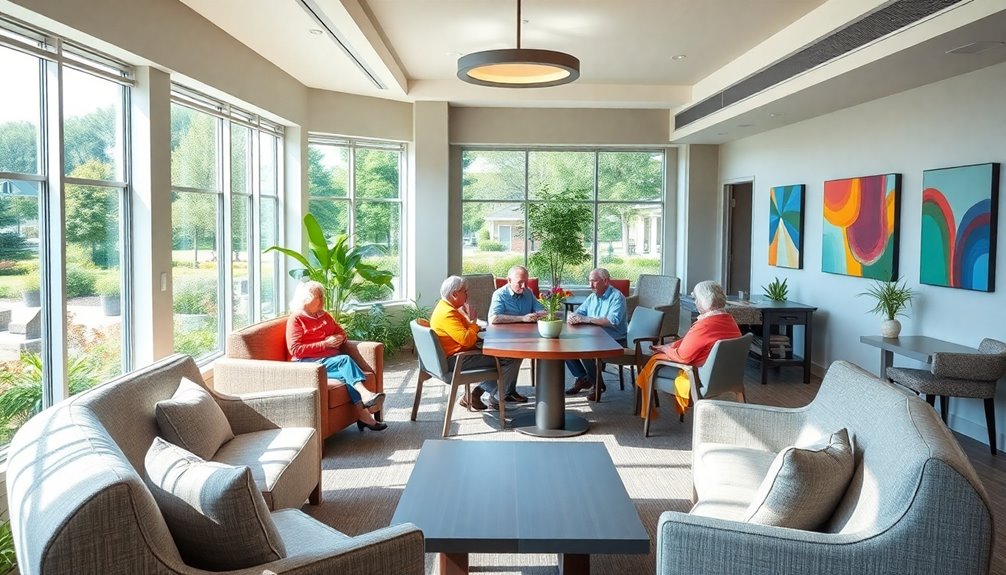
As the landscape of senior living evolves, Continuing Care Retirement Communities (CCRCs) are redefining themselves to prioritize flexibility and resident choice.
These modern CCRCs focus on design strategies that foster independence and self-determination, moving away from rigid structures. You'll find environments that encourage social engagement, promoting an active lifestyle rather than withdrawal.
Many facilities are situated near universities, allowing you to access cultural and educational opportunities. The redesign includes smaller, neighborhood-like settings that feel more intimate and home-like.
Additionally, CCRCs now offer a full spectrum of care, facilitating seamless shifts between independent living, assisted living, and skilled nursing as your needs change. This evolution guarantees a supportive, vibrant community tailored to your lifestyle, with an emphasis on maintaining children's welfare to ensure that families can thrive together in this new environment.
Seeking More Sustainable Environments

Sustainable design is becoming essential in senior homes, ensuring that living environments aren't only comfortable but also eco-friendly. By incorporating eco-friendly materials and practices, these homes reduce their environmental impact while promoting healthier living.
You'll find energy-efficient lighting and appliances that lower utility costs, alongside ample natural light from larger windows and skylights, enhancing both aesthetics and well-being.
- Green spaces for relaxation and social interaction
- Improved air quality contributing to better health
- Adaptive reuse of existing buildings preserving community heritage
- Opportunities for residents to engage in eco-friendly practices
These features not only create inviting spaces but also foster a sense of community and sustainability that enriches the lives of seniors.
Frequently Asked Questions
What Are the Costs Associated With Age-Friendly Design Features?
When considering age-friendly design features, you'll find various costs involved.
Depending on the specific modifications, expenses can range from simple changes, like installing grab bars, to more extensive renovations, such as widening doorways.
You'll also want to factor in materials, labor, and potential permits.
While upfront costs might seem high, investing in these features often leads to long-term savings in healthcare and improved quality of life, making it a wise decision.
How Can Families Participate in the Design Process for Senior Homes?
When you're diving into designing a senior home, think of it like throwing a big family bash—everyone's got a role!
Gather your loved ones to share ideas and preferences. You can sketch out layouts or pick color schemes together.
Don't forget to involve seniors in the conversation; their input's gold!
Are There Age-Friendly Design Options for Outdoor Spaces?
Absolutely, there are several age-friendly design options for outdoor spaces.
You can incorporate smooth pathways to guarantee easy navigation, add benches with armrests for resting, and include raised garden beds that make planting accessible.
Consider using non-slip surfaces and shaded areas to enhance safety and comfort.
Additionally, you might opt for clear signage and good lighting to help everyone feel secure and at ease while enjoying the outdoors.
What Materials Are Recommended for Age-Friendly Home Renovations?
When considering age-friendly home renovations, focus on materials that enhance safety and accessibility.
You'll want to choose non-slip flooring options like vinyl or textured tiles to prevent falls. For countertops, durable surfaces like quartz or solid surface are ideal, as they're easy to clean and maintain.
Additionally, opt for lightweight, sturdy furniture that's easy to move. Using bright, contrasting colors can also help with visibility and navigation in your space.
How Can Age-Friendly Designs Be Adapted for Different Cultural Preferences?
You can adapt age-friendly designs by incorporating elements that reflect different cultural preferences.
Start by engaging with community members to understand their values and traditions. Choose colors, materials, and layouts that resonate with their heritage.
For instance, you might include open spaces for gatherings or specific flooring that's comfortable for prayer.
Conclusion
As you explore these age-friendly design trends, remember that creating a welcoming environment for seniors is like crafting a warm embrace. By prioritizing comfort, privacy, and community, you can transform contemporary senior homes into vibrant havens of dignity and joy. Embracing these innovative concepts not only enhances quality of life but also acknowledges the unique needs of our aging population. Together, let's build spaces that nurture the spirit and make every day a little brighter for our seniors.
